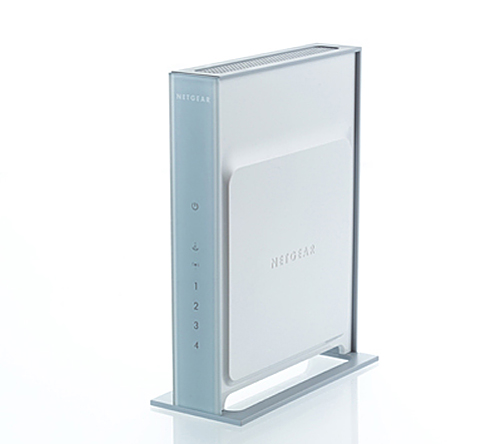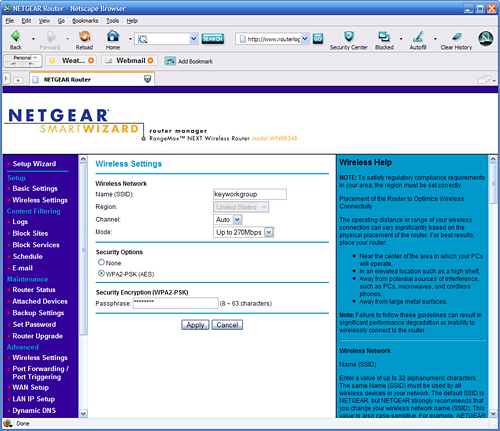Draft N Router Coverage: When the "n" in 802.11n really means "not yet"
by Gary Key on August 30, 2006 5:00 AM EST- Posted in
- Networking
NETGEAR WNR834B

The new RangeMax Next series sports a new case design compared to previous RangeMax units. The RangeMax Next is a slim and sleek design with internal antennas instead of the typical external three antenna design. While having a very elegant design, it does not have a wall-mount option, and needs to be placed upright in order for the antenna to be properly oriented. The unit is very light and we experienced several situations where our cluttered test cable layout would pull the unit over on its side. Unlike the external unit designs, the only way to orient the antenna for better signal strength is to move the actual box around. The front panel has seven status lights that correspond to the LAN/WAN jacks, power status, and communication link with your wireless client.

Due to the internal antenna placement the case is actually very thin with the rear panel consisting of the standard four 10/100 LAN jacks, one WAN jack, 12V power jack, and a pinhole reset button with proper color coding on each connection.
The included customer documentation is organized and easy to follow, especially if you have prior router installation experience. Upon opening the box you find a well labeled installation CD that informs you how to start the installation process. After the CD starts up you will come to a web-based menu that offers several options for setting up the router or reviewing the owner's manual.
You have two setup options that consist of a beginner's installation wizard or the option to configure the router manually by connecting directly to the browser based tool. The wizard will instruct the user in setting up the hardware and then offers a simple software setup routine. If you manually set up the router the configuration tool can be reached by entering the enclosed IP address or simply typing www.routerlogin.net.
Our first time network users found the NETGEAR browser tool to be very informative and almost as intuitive as the Belkin N1 while easily exceeding the Linksys documentation. NETGEAR only offers a limited one year warranty on this product and we found their technical support group to be very good at answering our questions.

The new RangeMax Next series sports a new case design compared to previous RangeMax units. The RangeMax Next is a slim and sleek design with internal antennas instead of the typical external three antenna design. While having a very elegant design, it does not have a wall-mount option, and needs to be placed upright in order for the antenna to be properly oriented. The unit is very light and we experienced several situations where our cluttered test cable layout would pull the unit over on its side. Unlike the external unit designs, the only way to orient the antenna for better signal strength is to move the actual box around. The front panel has seven status lights that correspond to the LAN/WAN jacks, power status, and communication link with your wireless client.

Due to the internal antenna placement the case is actually very thin with the rear panel consisting of the standard four 10/100 LAN jacks, one WAN jack, 12V power jack, and a pinhole reset button with proper color coding on each connection.
 |
| Click to enlarge |
The included customer documentation is organized and easy to follow, especially if you have prior router installation experience. Upon opening the box you find a well labeled installation CD that informs you how to start the installation process. After the CD starts up you will come to a web-based menu that offers several options for setting up the router or reviewing the owner's manual.
You have two setup options that consist of a beginner's installation wizard or the option to configure the router manually by connecting directly to the browser based tool. The wizard will instruct the user in setting up the hardware and then offers a simple software setup routine. If you manually set up the router the configuration tool can be reached by entering the enclosed IP address or simply typing www.routerlogin.net.
Our first time network users found the NETGEAR browser tool to be very informative and almost as intuitive as the Belkin N1 while easily exceeding the Linksys documentation. NETGEAR only offers a limited one year warranty on this product and we found their technical support group to be very good at answering our questions.










22 Comments
View All Comments
shoRunner - Wednesday, August 30, 2006 - link
As hinted at in the article the overall reliability of these draft-n routers is terrible. Having setup 60+ wireless networks in the past few months using many different kinds of routers including these draft-n routers, they have performed very badly some models requiring daily powercycling and constant firmware updates. If you are looking for a reliable fast wireless network the netgear 240 pre-n router is definately the better buy.Myrandex - Wednesday, August 30, 2006 - link
The Dlink DGL-1000 router has gigabit ethernet and is freaking amazing. Not to mention I enjoy the blue LEDs on the frong, and performance is nice.Jason
blckgrffn - Wednesday, August 30, 2006 - link
If were are going to sustain 300 megabit throughput on our wireless devices, why isn't the wired backend gigabit?Seriously, early adopters of this stuff are also likely to have gigabit networking equipment, as that has been shipping in volume for the at least the last three years or so, and really became affordable as far as switches go last year. My $30 D-link gigabit switch has been working just fine...
Nat
bobsmith1492 - Wednesday, August 30, 2006 - link
On page 2, the feature chart states the three routers have 2.4 GHz bandwidth... I believe that is actually their operating frequency.erwos - Wednesday, August 30, 2006 - link
The spectrum nuking issue is a real concern to me. I live in an apartment building, so I'm already getting crowded by random wireless phones and microwaves all around me. I _shudder_ to think what will happen when some of these "draft 802.11n" devices become more common. I wish I could claim this kind of callousness was because of 802.11n, but I know it's not true - the original channel bonding schemes for 802.11b/g were infamous for this kind of thing.I'm trying my best to be a good citizen and turn that sort of stuff off, but I fear I may to have move to 802.11a, and the less-troubled 5ghz band, soon.
-Erwos
DigitalFreak - Wednesday, August 30, 2006 - link
I moved to 802.11a a long time ago, after more and more b/g APs started showing up. Been running great every since.I really have to wonder why the IEEE didn't use the 5ghz frequency for 11n. I know 11a has a shorter range than 11b/g, but I would think it would be easier to overcome that problem than it is to get past the major spectrum issues in the 2.4Ghz range.
yyrkoon - Wednesday, August 30, 2006 - link
Well, atleast not here in the US I mean.yyrkoon - Wednesday, August 30, 2006 - link
2.4GHZ isnt regulated, 5.8GHZ may be, I'm not sure.Lonyo - Wednesday, August 30, 2006 - link
802.11n might be useful in the home eventually as broadband gets faster (30mbps+ connections), but for real high speed networking, it seems wired is still the only option.Can't say it's so suprising, but at least wireless is getting more useful in terms of matching increasing broadband speeds (although with existing MIMO, .11n isn't quite so useful yet, until it can exceed MIMO).
LoneWolf15 - Wednesday, August 30, 2006 - link
Are you kidding? There are far more reasons for high-speed wireless in the home than just broadband. Streaming media servers (having all my movies, music, etc. on a server that can be streamed to an HTPC or appliance) are a prime example of a good use of high-speed WiFi, especially for those of us that don't wish to deal with rewiring CAT-5 in our houses.As for .11n, it isn't useful yet because there isn't a standard, and yet vendors are trying to capitalize on a need by releasing hastily-designed pre-standard product. It's not robust, and it requires proprietary hardware. When the IEEE finally figures this out (IMO, it should have been some time ago, they've had enough time, though dealing with bickering vendors is an issue) and issues a true standard, things should work out better, much like when V.90 finally was ratified.